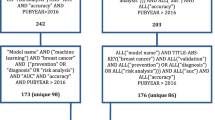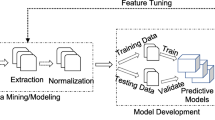Abstract
An early detection of a disease can save many lives but it is impractical to undergo all medical tests for many prevalent diseases. Further these tests are costly, painful, time consuming and may have side effects. We have tried to predict esophageal cancer using demographics, lifestyle, medical history information, and basic clinical tests initially and later removed all clinical tests one after another to study the change of the accuracy without these clinical tests. It is well studied that no single classification technique turns out to be best for all the problems. Here, we test Naive Bayes classification, random forests, support vector machines (SVM) and logistic regression (LR), which perform similarly when all tests are used. However, as we reduce the number of tests, naive versions of these classifiers perform worse than kernelized versions of SVM and LR. We test our methodology with electronic medical record (EMR) of 3500 patients (approx.). The four methods described above, demonstrate a high accuracy with all features, including basic clinical test and show very low accuracy without the basic clinical tests measured by medical practitioner (MP). LR with a polynomial feature transformation of degree three yields an accuracy of 100% (approx), even without the MP features. Further dropping clinical tests one after another we see a decline in the accuracy of detection to 96%. We have also observed high sensitivity to 100% which indicates that no real patients are undetected in this experiment.






Similar content being viewed by others
References
Edgren, G., Adami, H.O., Nyren, O., Weiderpass, E.: A global assessment of the oesophageal adenocarcinoma epidemic. Int. J. Gastroenterol. Hepatol. (2012). https://doi.org/10.1136/gutjnl-2012-302412
Scott B., Health W.: Incidence of esophageal cancer linked to gerd, http://www.news-medical.net/news/20150421/Incidence-of-esophageal-cancer-linked-to-GERD-rises-six-fold-in-recent-decades.aspx. Online; Accessed 21 Dec 2015
Cancer-Research-UK, Oesophageal cancer incidence statistics, http://www.cancerresearchuk.org/content/oesophageal-cancer-incidence-statistics#ref-2. Online; Accessed 21 Dec 2015
Blot W., McLaughlin J.: The changing epidemiology of esophageal cancer. Semin. Oncol. 26 (5 Suppl 15). http://europepmc.org/abstract/MED/10566604
Jensen, P.B., Jensen, L.J., Brunak, S.: Mining electronic health records: towards better research applications and clinical care. Nat. Rev. Genet. 13(6), 395–405 (2012). https://doi.org/10.1038/nrg3208
Alolfe M.A., Youssef A.B.M., Kadah Y.M., Mohamed A.S.: Development of a computer-aided classification system for cancer detection from digital mammograms, In: Radio Science Conference, NRSC 2008. National, 2008, pp. 1–8. https://doi.org/10.1109/NRSC.2008.4542383 (2008)
Abreu P.H., Hugo Amaro D., C. Silva, Machado P., Abreu M.H., Afonso N., Dourado A.: Overall survival prediction for women breast cancer using ensemble methods and incomplete clinical data, pp. 1366–1369. https://doi.org/10.1007/978-3-319-00846-2_338 (2014)
Jacob S.G., Ramani R.G.: Efficient classifier for classification of prognostic breast cancer data through data mining techniques. In: Proceedings of the World Congress on Engineering and Computer Science, vol. 1, pp. 24–26 (2012)
Ramani, R.G., Jacob, S.G.: Improved classification of lung cancer tumors based on structural and physicochemical properties of proteins using data mining models. PLoS ONE 8(3), e58772 (2013)
Alizadehsani, R., Habibi, J., Hosseini, M.J., Mashayekhi, H., Boghrati, R., Ghandeharioun, A., Bahadorian, B., Sani, Z.A.: A data mining approach for diagnosis of coronary artery disease. Comput. Methods Progr. Biomed. 111(1), 52–61 (2013). https://doi.org/10.1016/j.cmpb.2013.03.004
Peter T.J., Somasundaram K.: An empirical study on prediction of heart disease using classification data mining techniques. In: 2012 International Conference on Advances in Engineering, Science and Management (ICAESM), pp. 514–518 (2012)
Nahar, J., Imam, T., Tickle, S.K., Chen, P.Y.P.: Association rule mining to detect factors which contribute to heart disease in males and females. Expert Syst. Appl. 40(4), 1086–1093 (2013). https://doi.org/10.1016/j.eswa.2012.08.028
Austin, P.C., Tu, J.V., Ho, J.E., Levy, D., Lee, D.S.: Using methods from the data-mining and machine-learning literature for disease classification and prediction: a case study examining classification of heart failure subtypes. J. Clin. Epidemiol. (2013). https://doi.org/10.1016/j.jclinepi.2012.11.008
Shouman M., Turner T., Stocker R.: Using data mining techniques in heart disease diagnosis and treatment. In: 2012 Japan–Egypt Conference on Electronics, Communications and Computers (JEC-ECC), 2012, pp. 173–177. https://doi.org/10.1109/JEC-ECC.2012.6186978
Wu, J., Roy, J., Stewart, W.F.: Prediction modeling using EHR data: challenges, strategies, and a comparison of machine learning approaches. Med. Care 48(6), S106–S113 (2010)
Penny K.I., Smith G.D.: The use of data-mining to identify indicators of health related quality of life in patients with irritable bowel syndrome. In: Proceedings of the ITI 2009 31st International Conference on Information Technology Interfaces, 2009. ITI ’09, pp. 87–92 (2009). https://doi.org/10.1109/ITI.2009.5196059
Leke-Betechuoh B., Marwala T., Tim T., Lagazio M.: Prediction of HIV status from demographic data using neural networks. In: 2006 IEEE International Conference on Systems, Man and Cybernetics, vol. 3, pp. 2339–2344 (2006). https://doi.org/10.1109/ICSMC.2006.385212
Altikardes, Z.A., Erdal, H., Baba, A.F., Tezcan, H., Fak, A.S., Korkmaz, H.: A study to classify non-dipper/dipper blood pressure pattern of type 2 diabetes mellitus patients without holter device, In: 2014 World Congress on Computer Applications and Information Systems (WCCAIS), pp. 1–5 (2014) https://doi.org/10.1109/WCCAIS.2014.6916555
Raju, D., Su, X., Patrician, P.A., Loan, L.A., McCarthy, M.S.: Exploring factors associated with pressure ulcers: a data mining approach. Int. J. Nurs. Stud. 52, 102–111 (2015). https://doi.org/10.1016/j.ijnurstu.2014.08.002
Dai, W., Brisimi, T.S., Adams, W.G., Mela, T., Saligrama, V., Paschalidis, I.C.: Prediction of hospitalization due to heart diseases by supervised learning methods. Int. J. Med. Inf. 84(3), 189–197 (2015). https://doi.org/10.1016/j.ijmedinf.2014.10.002
Fawcett, T.: An introduction to ROC analysis. Pattern Recogn. Lett. 27(8), 861–874 (2006). https://doi.org/10.1016/j.patrec.2005.10.010
Swets, J.A.: Signal Detection Theory and Roc Analysis in Psychology and Diagnostics: Collected Papers. Lawrence Erlbaum Associates, Mahwah (1996)
Hastie, T., Tibshirani, R., Friedman, J.: The Elements of Statistical Learning, vol. 2. Springer, New York (2009). https://doi.org/10.1007/978-0-387-84858-7
Davis J., Goadrich M.: The relationship between precision–recall and roc curves, In: Proceedings of the 23rd International Conference on Machine Learning, ACM, pp. 233–240 (2006)
Zhu J., Hastie T.: Kernel logistic regression and the import vector machine. In: Advances in neural information processing systems, pp. 1081–1088 (2001)
Le Cessie, S., Van Houwelingen, J.: Ridge estimators in logistic regression. Appl. Stat. 41, 191–201 (1992)
Cortes, C., Vapnik, V.: Support-vector networks. Mach. Learn. 20(3), 273–297 (1995). https://doi.org/10.1007/BF00994018
Scholkopf, B., Sung, K.-K., Burges, C.J.C., Girosi, F., Niyogi, P., Poggio, T., Vapnik, V.: Comparing support vector machines with gaussian kernels to radial basis function classifiers. IEEE Trans. Signal Process. 45(11), 2758–2765 (1997). https://doi.org/10.1109/78.650102
Zhang H.: The optimality of Naive Bayes. In: Proceedings of the Seventeenth International Florida Artificial Intelligence Research Society Conference, Miami Beach (2004)
Breiman, L.: Random forests. Mach. Learn. 45(1), 5–32 (2001). https://doi.org/10.1023/A:1010933404324
Biau, G.: Analysis of a random forests model. J. Mach. Learn. Res. 13(1), 1063–1095 (2012)
Hall, M., Frank, E., Holmes, G., Pfahringer, B., Reutemann, P., Witten, I.H.: The weka data mining software: an update. SIGKDD Explor. 11, 1871–1874 (2009)
Fan, R.-E., Chang, K.-W., Hsieh, C.-J., Wang, X.-R., Lin, C.-J.: LIBLINEAR: a library for large linear classification. J. Mach. Learn. Res. 9, 1871–1874 (2008)
Schölkopf, B., Smola, A.J.: Learning with kernels: support vector machines, regularization, optimization, and beyond. MIT press, London (2002)
Chang, C.-C., Lin, C.-J.: Libsvm: a library for support vector machines. ACM Trans. Intell. Syst. Technol. 2, 27:1–27:27 (2011)
Chawla, N.V., Bowyer, K.W., Hall, L.O., Kegelmeyer, W.P.: Smote: synthetic minority over-sampling technique. J. Artif. Intell. Res. 16, 321–357 (2002)
Author information
Authors and Affiliations
Corresponding author
Rights and permissions
About this article
Cite this article
Roy, A., Bhattacharya, S. & Guin, K. Prediction of esophageal cancer using demographic, lifestyle, patient history, and basic clinical tests. Int J Adv Eng Sci Appl Math 9, 214–223 (2017). https://doi.org/10.1007/s12572-017-0199-0
Published:
Issue Date:
DOI: https://doi.org/10.1007/s12572-017-0199-0




